According to the WHO, the proportion of older adults is growing faster than any other age group as a result of longer life expectancy and declining fertility rates1. Additionally, disparities in health care and mental health, in particular, continue to exist in rural populations, where older adults can be particularly at-risk given other health problems and potential limitations in access to appropriate care. Generally, studies have shown that rural older adults assess their health as poorer than that of their urban counterparts2. Gale and colleagues, as well as Todman and colleagues, point out that long-standing shortages of mental health services have shifted much of the burden of care for mental health issues in rural communities to the primary health care sector3,4. Given its impact, Chapman and Perry and also Steffens and Otey argue that older adult depression, and its consequences, is a condition that should be addressed not only at the individual level but as a public health problem5,6.
Past studies have demonstrated that up to 39% of older patients suffer from depression or depressive symptoms7-10. In Saudi Arabia, where living in remote areas was more likely associated with depression, Al-Shammari and Al-Subaie found depressive symptoms in 39% of older adults7. In China, Gao and colleagues reported that over 26% of rural residents 65 years and older living in two provinces met the criteria for mild depression, with a history of stroke or heart attack as risk factors for depression8. In the USA, in a study of older patients using a primary healthcare clinic, Glasser and colleagues found that over 22% exhibited mild to moderate depression; additionally, 20% of patients showed possible cognitive impairment9. Results affirmed a significant rate of mental health problems in outpatient settings9. Related to this, Luptak and colleagues point out that older adults are especially vulnerable to having depression overlooked because they generally receive health care from primary care providers11. Recognition and treatment of depression in older persons in rural areas is often difficult due to lack of professionals trained to assess and treat depression as well as the stigma associated with depression and other mental health conditions12,13. While depression in later life is generally regarded to be highly treatable, under-treatment is still common in this population14-19. Ell, as well as McCabe and colleagues, describe multiple categories of barriers to older adult depression care including patient, provider, workplace, and health system factors20,21.
The present study was conducted to look at rural older adults' experiences in depression care as well as perceptions of barriers and supports in mental health services in their local communities. Four key questions and guiding expectations were the focus of the study.
- What are the general perceptions of older rural adults regarding depression care and mental health care availability in their communities? It was expected that depression care would be problematic and that mental health care availability would be limited.
- What is the mental health status related to depression of older rural adults? It was expected that, consistent with past findings, indications of depression in the older adult population would exceed 20%.
- What do older adults view as barriers to depression care in rural communities? It was expected that barriers would include individual/personal barriers and system level barriers.
- What are the attitudes and experiences of rural older adults who are depressed or are at-risk for depression? It was expected that older adults at risk for depression would report different experiences in health care utilization and attitudes than those not at-risk.
The overall objective was to provide information on rural older adults' experiences of and attitudes toward depression care that can be useful in developing programs and policy for rural mental health care delivery. Analysis also explored the relationship between being at-risk for depression and the variables of age, gender and distance from a major metropolitan area.
Study population
Eligible older adults were age 50 years and older, and independently living in one of 12 communities in Northwest Illinois. Seven communities had populations of 5000 or less, three had populations of between 5001 and 20 000, and two had populations of over 20 000 (25 585 and 39 018, respectively). Seven of the eight counties in which the towns were located were either completely or partially designated primary care shortage areas, as determined by the Illinois Department of Public Health. One community was 20.9 km (13 miles) from the nearest metropolitan area; four were 32.2-43.5 km (20-27 miles) away; two were 51.5-62.8 km (32-39 miles) away, respectively; three were 67.6-69.2 km (42-43 miles) away; one was 86.9 km (54 miles) away; and one was 123.9 km (77 miles) away. The nearest community to the metropolitan area had a population of 25 585. Between size and distance to a large city, the 12 towns were rural locations, according to US Census definitions, with the exception of the town of 25 385 people located within 20.9 km (13 miles) of the metropolitan area. This town, however, did not have its own hospital and depended on the metropolitan area for mental health referrals and services. Within each community, a convenience sample of groups or organizations was targeted where older adults were likely to be present or to meet. These included two primary care physicians' offices, seven senior centers, one health fair, one fitness center and a church group.
Data collection
Each group or organization was contacted in advance, at which time the study was explained and permission sought to collect data. Members of the study team arranged a one-time visit to each site for data collection. In the physicians' offices, at the health fair and at the fitness center, patients or clients were approached and asked to complete a study questionnaire. At the senior centers and the church group, the study was explained and the questionnaire was given to meeting attendees. In all cases, potential participants had the option of completing the questionnaire at the time (which occurred most often) or taking the instrument and returning it in a pre-addressed, postage-paid envelope. No personal identifiers were included on the questionnaire.
Study questionnaire
The questionnaire was a self-report, self-administered instrument, which took between 20 to 30 minutes to complete. It was tested and piloted in relation to content and completion time. The survey was seven pages in length, consisting of six parts: (i) assessment of health status of the respondents based on ratings of their overall health using the SF-1222, symptoms experienced related to mental health, depression status as assessed through the Durham GRECC Depression Scale23, and questions on history of depression and treatment; (ii) awareness and use of mental health services and providers; (iii) information on attitudes and perceptions of local mental health and healthcare services, including statements on access, primary care physician involvement and supportive environment for depression problems, where participants were asked to specify extent of agreement on a four-point Likert scale ranging from strongly disagree to strongly agree; (iv) a list of barriers to diagnosis and effective management of older adults with depression, to which participants indicated yes or no to each barrier; (v) responses to questions about what might help doctors be most responsive to diagnosis and treatment of depression, scored from 1 = not at all helpful to 4 = very helpful; and (vi) background and demographic characteristics including age, gender, education, marital status and chronic medical conditions.
Regarding mental health symptoms, participants responded to a list of 12 conditions they could have experienced over the past year, which included such responses as sad mood, pain, decreased energy, anxiety/irritability, sleep disturbance, multiple worries/distress, and other. This was a listing of conditions used in a previous study of primary care physicians to determine what physicians looked for in both diagnosing and managing depression24. In terms of depression status, the Durham GRECC Depression Scale is an 11 item inventory used to assess risk for depression, with 83% sensitivity and 77% specificity23. It was selected for its ease in answering and brevity. It correlates well with other depression scales. For instance, in past research conducted by Doetch and colleagues25, the Durham GRECC, which was administered to primary care clinic outpatients along with the Geriatric Depression Scale (GDS)26, there was a high correlation between the GDS and the Durham GRECC (r=0.83). A score of 4 or more on the Durham GRECC indicates depression risk. The older adults were also asked to respond yes or no to the question: 'Have you ever been diagnosed with depression?'. The listing of barriers to depression care was obtained from findings identified in past research20,21. For analysis purposes, for the variable of age, respondents were grouped into two categories: 50 to 64 years and 65+ years. This is consistent with the WHO definition of 65 years and older often used as a breaking point due to retirement and retention practices in developed countries27.
Analysis
Data were analyzed using the Statistical Package for Social Sciences v18 (www.spss.com) software package. Analysis includes, first, presentation of descriptive information on respondent demographics and general health, their assessments of the community environment, including primary health care physician interactions, and awareness and use of mental health services in the community. This is followed, second, by an examination of the mental health symptoms and depressions status of the older adults. Third, potential barriers to effective depression care and management are examined, and results of the present study compared with past research on barriers to mental health care. Finally, comparisons in responses are made between rural older adults at-risk for depression and those not at-risk to examine the attitudes and experiences of rural older adults with depression in relation to service provision and depression care management. For this analysis, a depression status composite variable was computed, consisting of one of any combination of responses to: a past history of depression; depression checked in the list of current chronic medical conditions; and/or scoring at-risk for depression (4+) on the Durham GRECC depression scale (Chronbach's α = 0.708). This variable allows for better understanding of the range of attitudes and characteristics of rural older adults who have been at-risk for depression related to depression care management. Comparisons between at-risk and not at-risk groups were made using χ², Student's t-tests and odds ratios, as appropriate. The at-risk for depression variable and use of mental health services are also examined by age, gender and distance to metropolitan area to look at possible associations by demographic and location variables.
Ethics approval
No identifiers were included on the questionnaire, and the study was approved by the University of Illinois College of Medicine - Rockford Institutional Review Board (project #118963).
A total of 150 independently living older rural adults completed the study survey; 136 (90.7%) were from designated underserved areas. For the older adult respondents, 101 (67%) had to travel 51.5 km (32 miles) or more for availability of more comprehensive mental health services, including psychiatrists, psychologists and mental health social workers. Data were not collected on specific response rates at each site, but estimated response rates at each site type are: senior centers (55%), primary care clinics (65%), fitness center (95%) and church groups (95%). Overall, most people approached during the study agreed to complete the questionnaire. Reasons given to investigators for not completing a survey included lack of time, questionnaire looked too long, and one person did not feel that mental health was an 'issue' with her.
Demographic and general health information on participants is presented (Table 1). The majority of respondents (75.3%) were women. Over 70% of the rural adults were 65 years of age and older. The average number of years of education completed was 13.1 (SD=2.7), with only five respondents indicating education at the eighth grade level or below. Over one-half of participants (51.4%) were either married or living with a partner, with 36.8% widowed. Overall, our study had an over-representation of women compared to the average proportion of women in the targeted counties and the state: 50% and 51%, respectively. The percent of high school graduates (96.6%) was also higher than that for the targeted counties (87%) and for Illinois as a whole (86.2%).
Table 1: Demographic and general health characteristics
of Rural Older Adult Study participants in Northwest Illinois
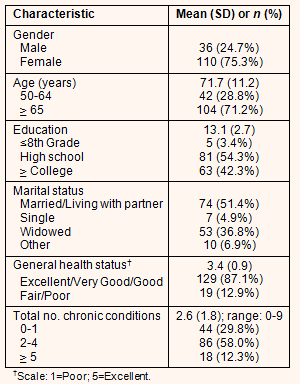
The vast majority of respondents (87.1%) characterized their health as either excellent, very good or good. The remaining 12.9% reported overall health status as fair or poor. A mean of 2.6 (SD=1.8) chronic conditions was reported by respondents. Chronic conditions included arthritis, cancer, chronic pain, depression, fatigue, glaucoma, headache, heart disease, hypertension, hyperlipidemia, obesity, stroke and the opportunity to indicate other. Only 9.6% of respondents reported no chronic medical conditions, with 29.1% indicating three or more conditions. Most often mentioned were heart disease (52.0%), arthritis (51.4%) and hypertension (44.6%).
The mean values as well as percentage of somewhat agree and strongly agree responses to five questions on local community capacity (CC) for mental health and depression support as well as six questions on assessment of primary health care (PHC) physician attributes related to depression management are presented (Table 2). Nearly 80% of respondents indicated there was enough information and support from their physician and in the community about depression and depression management and three-fourths further agreed the community has resources to help older people who are depressed. However, only one-half of respondents agreed that, overall, the healthcare system is set up to adequately meet the needs of older depressed people and that access to mental health care is available in the community. Less than 40% agreed that health professionals spend enough time with older people who are depressed. These community capacity responses (CC1 to CC5) were combined into an overall indicator of perception of supportive community capacity by adding the five items together and dividing by number of responses. The result was a mean score of 2.60 (SD=0.40; range = 1.40-3.75) on a scale with a potential range from a low of 1 to a high of 4, indicating a moderately positive assessment of community capacity.
In terms of primary health care, nearly all respondents agreed that their physician should be able to diagnose and treat older adults for depression. Nearly 80% felt their physician was up-to-date in knowledge and a little over three-quarters agreed that older adults expect primary health care physicians to deal with depression and to recognize and treat depression if the individual was depressed. Similarly, 75.4% agreed that their physician's office either takes or would take time to educate older people about their depression. However, consistent with the earlier concern that health professionals, in general, do not spend enough time with older depressed people, 71.6% of respondents also agreed that appointment times with physicians are usually too short for diagnosing and treating depression. Items PHC2 to PHC6 were combined into one index of PHC attributes, with average PHC attribute computed (note: PHC6 was reverse-coded for consistency in direction with the other items). The result was a mean score of 2.71 (SD=0.39; range = 1-4) on a scale that could possibly range from 1 to 4, indicating relatively positive assessments of physicians related to depression care. There was a slight, overall positive association between perceptions of PHC and CC (r=0.249; p=0.030).
The older adults tended to be aware of mental health and depression support services in the community, although at least one-third of respondents indicated not being aware of counseling from a church and hospital services and a little over 40% were not aware of any depression support groups in the community (Table 3). Nearly 75% of respondents reported never having used any of the mental health services. For those who did use services, church counseling, which most respondents also reported they were aware of, was most often utilized - by 9.3% of the older adults. Other services more often used were counseling from the doctor's office (8.6%), bereavement counseling (7.1%) and family or marital counseling (5.7%). Only 2.9% of respondents mentioned use of a depression support group or of a stress management group, respectively.
Table 2: Assessment of local community capacity for and primary health
care provider attributes in mental health and depression support
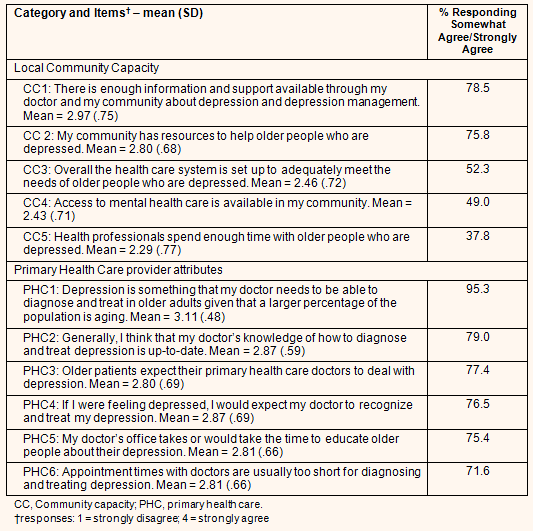
Table 3: Awareness and utilization of local services by older rural adults in Northwest Illinois
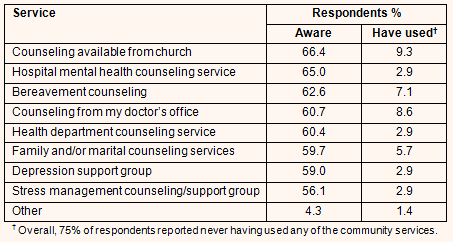
In response to mental and behavioral health symptoms experienced by the rural older adults in the past year, the average number of symptoms was 2.3 (range from 0 to 9) (Table 4). Almost 41% of participants indicated decreased energy, with other more frequently mentioned symptoms being sleep disturbance (37%) and weight loss or gain (32%). Over 35% of respondents indicated three or more mental/behavioral health concerns.
Focusing specifically on depression status, 23 respondents, or 17.8%, indicated that at some point they had been diagnosed with depression by a physician or other healthcare provider. Sixteen participants, or 11%, reported depression as a current chronic condition. Additionally, 17 of the 150 respondents, or 11.3%, scored in the range for possible current depression on the Durham GRECC scale for assessment of depression symptoms. When combining the results of the three depression assessments, 35 respondents (23.3%) showed evidence of depression or being at-risk for depression. In terms of point prevalence, 26.4% of women were at-risk for depression compared to 13.9% of rural men.
The results of the rural respondents' responses to a list of 17 barriers representing potential reasons for older adults with depression to be ineffectively managed are presented (Table 5). Overall, the mean number of barriers indicated by respondents was high at 7.8 (SD=4.6), with a range of 0-17. Just 3.6% of respondents reported no barriers to depression care and management. Most often reported as a barrier to effective management was stress in a person's life, with nearly seven out of 10 respondents indicating personal stress as an issue. This was followed closely by expense of health care/medical visits (67.1%). Denial and/or fear of depression, lack of perceived seriousness of disease on the depressed person's part and, again, limitations of time during office visits rounded out the top five reported barriers, with 62.9%, 62.3%, and 62.1%, respectively. Lack of available care in the area and lack of transportation were mentioned by 41.7% and 36.4% of respondents, respectively. When asked to circle the single most significant barrier that is a challenge to depression care and management, denial and/or fear of depression was most often selected (21.7%), followed by expense of health care (14.5%) and lack of perceived seriousness of disease on the part of the person who is depressed (13.0%).
Table 4: Mental health and depression characteristics of rural older adults in Northwest Illinois23
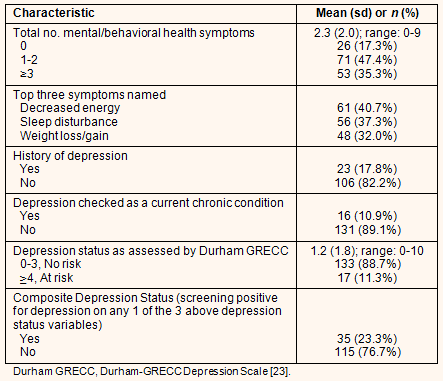
Table 5: Older adults' views of barriers to effective management of depression
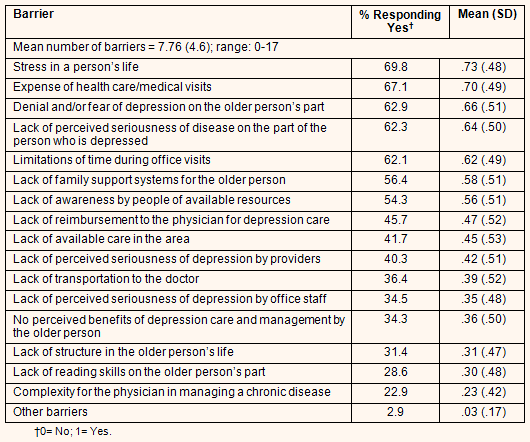
In comparing older rural adults at-risk for depression with those not at-risk, there were no statistically significant differences between groups related to the study demographic variables of gender and age, as well as distance to metropolitan area. The same was true for self-reported health status. However, those older adults at-risk for depression reported significantly more chronic conditions than those not at-risk: 3.8 versus 2.2 (t=4.13; p<0.001). In relation to mental health, those at-risk for depression were over three times as likely as those not at-risk to indicate three or more mental or behavioral health symptoms (p=0.002). In terms of reported experiences and perceptions toward the healthcare system and primary health care doctors, there were no significant differences between the responses of at-risk versus not at-risk older adults. Similarly, there was no difference between groups related to awareness and use of community mental health services. Overall, there was no difference in total barriers to depression care between the groups, where those at-risk and not at-risk reported a similar number of barriers: 8.2 and 7.6, respectively. While a majority of the rural older adults in general reported limitations of time in the physician's office as a barrier, those at-risk for depression were much more likely to view time as an issue in mental health care delivery: 78.8% versus 57.0% (p=0.024).
Discussion
Access and use of mental health care in rural communities increasingly falls within the province of the primary health care doctor2,11,12. Results demonstrate that older adults in rural communities generally approve of the care received from primary care physicians and of the availability of services in rural communities. However, in terms of overall feedback regarding provider and community support, responses were not overwhelmingly positive, with concern especially expressed regarding limitations of time with the physician, and over 60% of respondents viewing this as a barrier to effective management. Further, older adults at-risk for depression expressed greater concern about time limitations with physicians. This may be due to physician or health system factors, where primary care physicians may not have the resources and background to extensively treat depressed patients and/or may be pressured by administration to see as many patients as possible in the course of a work day. Alternatively, as Blaney points out, depressed patients may put emphasis on negative aspects of their experiences and be more likely to report concerns with their health care providers28. Either way, adequate time with primary care physicians was a concern expressed by these rural older adults. Finally, only one-half of respondents agreed that the healthcare system is set up to adequately meet the needs of older depressed people and that access to mental health care is available in the community. These concerns were expressed equally by those older adults at-risk and not at-risk for depression, as well as those at different distances from a larger metropolitan community.
Based on the composite variable, 23% of older rural adults were depressed or at-risk for depression. This is consistent with the results of past studies9,10,29. Specifically, Kaplan and Sadock stated that at least 15 to 20% of older people in the general population may experience depression29. Steffens and colleagues found that the point prevalence for depression in older adults was 4.4% in women and 2.7% in men30. In this study, using at-risk assessments based on self-report, 26.4% of women and 13.9% of older adult men were possibly experiencing depression. The results are based on self-reports, but proportionally are similar to Steffens and colleagues, where depression is over one-and-a-half times more likely to be found in women than men. Overall, while the present study was not designed to specifically assess prevalence of depression, this was a major health issue for older adults in this rural population.
The overall rate or frequency of utilization of mental health-related services appeared quite low relative to the rate of depression evidence as well as symptoms of behavioral and mental health problems, where the average number of problems reported by the rural older adults was three. While nearly 60% of older adults were aware of depression support groups, less than 3% had ever used these. This is consistent with the findings of Cohn-Mansfield and Frank who, in their study of older adults 57 years of age and older, demonstrated a high prevalence of needs among older adults yet low service use by those with need for services31. A challenge is matching needs to services or perhaps taking care of needs in the context of other services, such as visits to the primary care office.
Stress in a person's life and expense of health care were the most frequently mentioned barriers to effective management of depression by the rural respondents. One is a more personal and the other a more structural or systems barrier. Of the top five reported barriers, three were of a personal nature: in addition to stress were denial or fear of depression and lack of perceived seriousness of the disease. Importantly, all of the top five barriers were mutable; that is, these barriers to effective management of depression can be approached and solutions sought through education and changes in the delivery of healthcare services. When asked about the single most important barrier to depression care, nearly one-half of older adults identified a personal or psychological obstacle, including denial/fear and stress.
The fifth of the top five barriers, limitations of time in the office visit, was a recurrent theme among the older adults. While rural primary health care practice is not likely to get less busy in the future, interprofessional teams and sharing of responsibility in mental health care treatment and management could be adopted as a strategy for more effectively reducing the discrepancy between rural adults' awareness of depression services and their actual use of these.
These findings regarding barriers to care are consistent with past research delineating patient, provider and health service system barriers to depression care in older adults20. Results support the call from Von Korff and colleagues for improving depression care through such strategies as aligning efforts to improve care with broader strategies of improving care of other chronic conditions, increasing the availability of depression care services in primary health care and redefining the lack of time of primary health care providers for high quality depression care in the organization of care and provider training32. A major concern in the present study was what appeared to be an 'avoidance' factor, where there was a combination of denial on the part of the individual and lack of perceived seriousness on the part of both patient and provider, which can only lead to poor outcomes.
Glasser and colleagues examined rural primary health care physicians' experiences related to the diagnosis and treatment of depression, including perceived barriers to depression care in their practices33. Family physicians and general internists indicated that, on average, one-third of their patients were depressed. In terms of these providers' views of needed resources and support, most often mentioned were better availability of psychologists and counselors, increased time to spend with patients, and improved patient understanding and compliance. In this study of rural physicians, nearly one-half reported a gap between their preferred treatment of older depressed patients and the availability of treatment for these patients33. This appears to be a gap mutually recognized by both primary health care physicians and rural older adults in general.
Overall, as Gale and colleagues point out, long-term shortages of mental health services have shifted the burden of care for mental health issues to the primary health care sector, with the most commonly treated condition being depression3. The authors state that a key element of development of services is the presence of an internal mental health 'champion'. This could be a member of the interprofessional team, not necessarily the primary health care physician. The authors also observe that policymakers should develop approaches to address reimbursement and administrative barriers, while also considering how to train and ultimately recruit mental health providers to rural areas3. Important in this regard could be the more recently initiated joint medical residency program opportunities in family medicine or internal medicine and psychiatry in the USA.
The present study was limited to one region of one state. A sampling strategy of places was used rather than people, which limited responses to those actually taking part in events or activities. This no doubt partially explains the high educational status of the sample of rural older adults. Less independent and possibly less educated community members may not have been present at the selected sites. In this context, the results may represent a somewhat more informed and even positive side to mental health service availability, use and experiences than that of the more general rural population in the areas under study.
Additionally, the survey questions that focused on depression are self-assessments and self-reports. This is a study limitation. As discussed by Blaney, depressed people often have a greater recall of negative material and an under-recognition of positive material compared to people who are not depressed28. In the present study, this could have led to older adults at-risk for depression reporting more chronic conditions and mental health behavioral symptoms than non-depressed people. Further research should document chronic conditions and symptoms through record review rather than self-report. Nonetheless, the overall findings regarding depression status and experiences are not inconsistent with results of past studies showing prevalence of depression in older adults and the complex of poorer physical health being associated with poorer mental health34.
In terms of the status of rural older adults, this study affirms the presence of depression or being at-risk for depression in rural community-residing older people. This is true regardless of being in the category of young-old or older-old. It is likely that depression, as well as other mental health problems, remains under-diagnosed and under-treated in all rural older adults. Similar approaches to the identification and management of depression in older adults can be applied across the continuum. In this regard, results confirm issues of service availability, limitations of time in the physician's office and a large percentage of older rural adults in need of care for depression, whether young-old or older-old. For rural populations, in particular, these are not problems easily addressed, especially where stress in a person's life is identified as the major barrier to effective management of care of an older person with depression.
This study confirms that there is a gap in rural mental health care delivery. Primary health care physicians and other providers will continue to be at the 'forefront' for mental health diagnosis and management in rural communities. The challenge is understanding this responsibility and working with the community, providers, and patients to address disparities in rural mental health.
Acknowledgments
The authors thank the Illinois Rural Health Association for partial funding for this study and especially acknowledge the contributions of LaVonne A Straub to rural research.
References
1. World Health Organization. Health topics: Ageing. (Online) 2012. Available: www.who.int/topics/ageing/en (Accessed 31 March 2012).
2. Rosenthal T, Fox C. Access to health care for the rural elderly. JAMA 2000; 284: 2034-2036.
3. Gale J, Loux S, Shaw B, Hartley D. Encouraging rural health clinics to provide mental health services: what are the options? Research & Policy Brief. Portland, ME: Maine Rural Health Research Center, May 2010.
4. Todman JPF, Law J, MacDougall A. Attitudes of GPs towards older adults psychology services in the Scottish Highlands. Rural and Remote Health 11:1496. (Online) 2011. Available: www.rrh.org.au (Accessed 4 November 2012).
5. Chapman DP, Perry GS. Depression as a major component of public health for older adults. Preventing Chronic Disease 2008; 5(1): 1-9.
6. Steffens DC, Otey E, Alexopoulis GS, Butters MA, Cuthbert B, Ganquli M et al. Perspectives on depression, mild cognitive impairment, and cognitive decline. Archives of General Psychiatry 2006; 63(2): 130-138.
7. Al-Shammari SA, Al-Subaie A. Prevalence and correlates of depression among Saudi elderly. International Journal of Geriatric Psychiatry 1999; 14: 739-747.
8. Gao S, Jin Y, Unverzagt FW, Liang C, Hall KS, Ma F et al. Correlates of depressive symptoms in rural elderly Chinese. International Journal of Geriatric Psychiatry 2009; 24(12): 1358-1366.
9. Glasser M, Stearns JA, de Kemp E, van Hout J, Hott D. Dementia and depression symptomatology as assessed through screening tests of older patients in an outpatient clinic. Family Practice Research Journal 1994; 14(3): 261-272.
10. Licht-Strunk E, van der Kooij KG, van Schaik DGF, van Marwijk HW, van Hout HP, de Haan M et al. Prevalence of depression in older patients consulting their general practitioner in The Netherlands. International Journal of Geriatric Psychiatry 2005; 20(11): 1013-1019.
11. Luptak M, Kaas M, Artz M, McCarthy T. Project ADAPT: a program to assess depression and provide proactive treatment in rural areas. The Gerontologist 2008; 48(4): 542.
12. Badger L, Robinson H, Farley T. Management of mental disorders in rural primary care: a proposal for integrated psychosocial services. Journal of Family Practice 1999; 48(10): 813-818.
13. Probst J, Laditka S, Moore C, Harun N, Powell M, Baxley E. Rural-urban differences in depression prevalence: implications for family medicine. Family Medicine 2006; 38(9): 653-660.
14. Alexopoulos GS. Depression in the elderly. Lancet 2005; 365(9475): 1961-1970.
15. Unutzer J, Katon W, Callahan CM, Williams JW Jr, Hunkeler E, Harpole L et al. Collaborative care of late-life depression in the primary care setting: a randomized controlled trial. JAMA 2002; 288(22): 2836-2845.
16. Gilbody S, Whitty P, Grimshaw J, Thomas R. Educational and organizational interventions to improve the management of depression in primary care. JAMA 2003; 289(23): 3145-3151.
17. Beekman AT, Deeg DJ, Braam AW, Smit JH, van Tilburg W. Consequences of major and minor depression in later life: a study of disability, well-being and service utilization. Psychological Medicine 1997; 27(6): 1397-1409.
18. Charney DS, Reynolds CF, Lewis L, Lebowitz BD, Sunderland T, Alexopoulis GS. Depression and bipolar support alliance consensus statement on the unmet needs in diagnosis and treatment of mood disorders in late life. Archives of General Psychiatry 2003; 60(7): 664-672.
19. Burroughs H, Lovell K, Morley M, Baldwin R, Burns A, Chew-Graham C. 'Justifiable depression': how primary care professionals and patients view late-life depression? Family Practice 2006; 23(3): 369-377.
20. Ell K. Depression care for the elderly: reducing barriers to evidence based practice. Home Health Care Service Quarterly 2006; 25(1-2): 115-148.
21. McCabe MP, Davison T, Mellor D, Kuruvilla G. Barriers to care for depressed older people: perceptions of aged care among medical professionals. International Journal on Aging and Human Development 2009; 68(1): 53-64.
22. Failde I, Medina P, Ramirez C, Arana R. Construct and criterion validity of the SF-12 health questionnaire in patients with acute myocardial infarction and unstable angina. Journal of Evaluation in Clinical Practice 2010; 16(3): 569-573.
23. Koenig HG, Cohen HJ, Blazer DG, Meador KG, Westlund R. A brief depression scale for use in the medically ill. International Journal of Psychiatry and Medicine 1992; 22(2): 183-195.
24. Glasser M, Gravdal J. Assessment and treatment of geriatric depression in primary care settings. Archives of Family Medicine 1997; 6: 433-438.
25. Doetch TM, Alger BH, Glasser M, Levenstein J. Detecting depression in elderly outpatients: findings from depression symptom scales and the Dartmouth COOP charts. Family Medicine 1994; 26: 519-523.
26. Brink TL, Yesavage JA, Lunn O, Heersema PH, Adey M, Rose TL et al. Screening tests for geriatric depression. Clinical Gerontologist 1982; 1: 31-33.
27. World Health Organization. Definition of an older or elderly person. (Online) 2012. Available: http://www.who.int/healthinfo/survey/ageingdefnolder/en/index.html (Accessed 17 July 2012).
28. Blaney PH. Affect and memory: a review. Psychological Bulletin 1986; 99(2): 229-246.
29. Kaplan HI, Sadock BJ. Synopsis of psychiatry. Philadelphia: Lippincott Williams & Wilkens, 1998.
30. Steffens DC, Skoog I, Norton MC, Hart AD, Tschanz JT, Plassman BL et al. Prevalence of depression and its treatment in an elderly population: the Cache County study. Archives of General Psychiatry 2000; 57(6): 601-607.
31. Cohn-Mansfield J, Frank J. Relationship between perceived needs and assessed needs for community services in community-dwelling older persons. The Gerontologist 2005; 48(4): 505-516.
32. Von Korff M, Katon W, Unutzer J, Wells K, Wagner EH. Improving depression care: barriers, solutions, and research needs. Journal of Family Practice 2001; 50(6): 529.
33. Glasser M, Vogels L, Gravdal J. Geriatric depression assessment by rural primary care physicians. Rural and Remote Health 9: 1180. (Online) 2009. Available: www.rrh.org.au (Accessed 4 November 2012).
34. Wiltens MMHA, Theunissen C, Glasser M, Zeitz H. Asthma and depression: a focus on the patient factors of asthma knowledge, asthma severity, and coping. Journal of Clinical Outcomes Management 2012; 19(6): 1-6.



